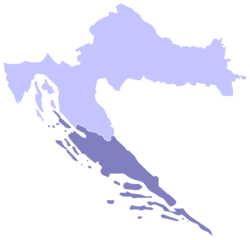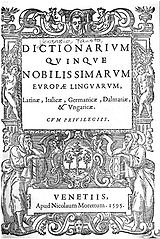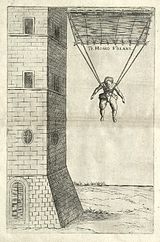Difference between revisions of "Directory:Fausto Veranzio"
m (page tidy) |
(added image) |
||
| Line 1: | Line 1: | ||
{{DISPLAYTITLE:Fausto Veranzio}} | {{DISPLAYTITLE:Fausto Veranzio}} | ||
This is about [[Wikipedia|Wikipedia's]] article on ''Fausto Veranzio''. | This is about [[Wikipedia|Wikipedia's]] article on ''Fausto Veranzio''. | ||
| − | + | [[File:250px-Croatia-Dalmatia.png|thumb|right|400px|Dalmatia (the dark purple) within todays modern [[Croatia]]]] | |
'''Fausto Veranzio''' is another article on Wikipedia that exhibits [[Nationalistic Editing on Wikipedia|nationalistic editing]]. Fausto Veranzio (or ''Faust Vrančić'' in modern [[Croatia|Croatian]]) <ref> Pronounced in Croatian -''Vranchich''. The last ''ch'' is pronounce more softly.</ref> is a individual with a Dalmatian heritage.<ref>[http://books.google.co.uk/books?id=wBg90lSgkQQC&pg=PA121&dq=Travels+Into+Dalmatia++Veranzio&hl=en&ei=eYSsTJ6_M4q4vgPk6oWnBw&sa=X&oi=book_result&ct=result&resnum=1&ved=0CDIQ6AEwAA#v=onepage&q&f=false Travels Into Dalmatia] by Abbe Alberto Fortis (p121)</ref> Fausto was born in Sibenik <ref>[http://books.google.com.au/books?id=6GgyiMd6u8MC&pg=PA95&dq=Fausto+Veranzio+Sebenico&hl=en&ei=dNqSTdriN4X5cdCKzYkH&sa=X&oi=book_result&ct=result&resnum=1&ved=0CCkQ6AEwAA#v=onepage&q=Fausto%20Veranzio%20Sebenico&f=false Ancient Engineers' Inventions:] Precursors of the Present ''by'' Cesare Rossi, Flavio Russo & Ferruccio Russo (p95) | '''Fausto Veranzio''' is another article on Wikipedia that exhibits [[Nationalistic Editing on Wikipedia|nationalistic editing]]. Fausto Veranzio (or ''Faust Vrančić'' in modern [[Croatia|Croatian]]) <ref> Pronounced in Croatian -''Vranchich''. The last ''ch'' is pronounce more softly.</ref> is a individual with a Dalmatian heritage.<ref>[http://books.google.co.uk/books?id=wBg90lSgkQQC&pg=PA121&dq=Travels+Into+Dalmatia++Veranzio&hl=en&ei=eYSsTJ6_M4q4vgPk6oWnBw&sa=X&oi=book_result&ct=result&resnum=1&ved=0CDIQ6AEwAA#v=onepage&q&f=false Travels Into Dalmatia] by Abbe Alberto Fortis (p121)</ref> Fausto was born in Sibenik <ref>[http://books.google.com.au/books?id=6GgyiMd6u8MC&pg=PA95&dq=Fausto+Veranzio+Sebenico&hl=en&ei=dNqSTdriN4X5cdCKzYkH&sa=X&oi=book_result&ct=result&resnum=1&ved=0CCkQ6AEwAA#v=onepage&q=Fausto%20Veranzio%20Sebenico&f=false Ancient Engineers' Inventions:] Precursors of the Present ''by'' Cesare Rossi, Flavio Russo & Ferruccio Russo (p95) | ||
* According to some sources the settlement was established by Croatians (Slavs) in the 11th century, and was given its name, '''Šibenik''' (the Š is pronounced ''sh'' ). The Slavs invaded the region in the early Middle Ages. It was latter renamed Sebenico then change back to Šibenik.</ref> circa 1551 in '''Dalmatia''', a region of the ''Republic of Venice'' in todays modern Croatia. <ref> Under the Treaty of Rapallo (in 1920 between [[Italy]] and the Kingdom of Serbia, Croatia & Slovenia.), Dalmatia became part of the Kingdom of Serbia, Croatia & Slovenia which was renamed Kingdom of Yugoslavia in 1929. After [[World War II]] Dalmatia was divided between three republics of [[Communists|Communist]] Yugoslavia. Most of her territory went to [[Croatia]]. In 1991 the ''Republic of Croatia'' became independent.</ref> In the 19th century Dalmatia became a province of the [[Austria|Austro]]-Hungarian Empire (Kingdom of Dalmatia). Dalmatia as a province, dates back to the Roman Empire <ref>[http://books.google.com.au/books?id=j-0LAAAAYAAJ&pg=PA158&dq=Roman+empire+province+Dalmatia&hl=en&ei=jfupTJO8JYuSuwO49cTJDA&sa=X&oi=book_result&ct=result&resnum=2&ved=0CDMQ6AEwAQ#v=onepage&q=Roman%20empire%20province%20Dalmatia&f=false The History of the Decline and Fall of the Roman Empire, Volume 1] by Edward Gibbon (p158)</ref> and is several centuries older than Croatia itself. Additionally he was '''historically''' a citizen of the ''Republic of Venice''. Fausto was a brilliant scientist in his day and is noted for his invention of the parachute.<ref>[http://books.google.co.uk/books?lr=&cd=27&num=100&as_brr=0&id=TM2EAAAAIAAJ&dq=Fausto+Veranzio+italian&q=Fausto+Veranzio+Venetian#search_anchor He's in the Paratroops Now] by Alfred Day Rathbone (p172)</ref> | * According to some sources the settlement was established by Croatians (Slavs) in the 11th century, and was given its name, '''Šibenik''' (the Š is pronounced ''sh'' ). The Slavs invaded the region in the early Middle Ages. It was latter renamed Sebenico then change back to Šibenik.</ref> circa 1551 in '''Dalmatia''', a region of the ''Republic of Venice'' in todays modern Croatia. <ref> Under the Treaty of Rapallo (in 1920 between [[Italy]] and the Kingdom of Serbia, Croatia & Slovenia.), Dalmatia became part of the Kingdom of Serbia, Croatia & Slovenia which was renamed Kingdom of Yugoslavia in 1929. After [[World War II]] Dalmatia was divided between three republics of [[Communists|Communist]] Yugoslavia. Most of her territory went to [[Croatia]]. In 1991 the ''Republic of Croatia'' became independent.</ref> In the 19th century Dalmatia became a province of the [[Austria|Austro]]-Hungarian Empire (Kingdom of Dalmatia). Dalmatia as a province, dates back to the Roman Empire <ref>[http://books.google.com.au/books?id=j-0LAAAAYAAJ&pg=PA158&dq=Roman+empire+province+Dalmatia&hl=en&ei=jfupTJO8JYuSuwO49cTJDA&sa=X&oi=book_result&ct=result&resnum=2&ved=0CDMQ6AEwAQ#v=onepage&q=Roman%20empire%20province%20Dalmatia&f=false The History of the Decline and Fall of the Roman Empire, Volume 1] by Edward Gibbon (p158)</ref> and is several centuries older than Croatia itself. Additionally he was '''historically''' a citizen of the ''Republic of Venice''. Fausto was a brilliant scientist in his day and is noted for his invention of the parachute.<ref>[http://books.google.co.uk/books?lr=&cd=27&num=100&as_brr=0&id=TM2EAAAAIAAJ&dq=Fausto+Veranzio+italian&q=Fausto+Veranzio+Venetian#search_anchor He's in the Paratroops Now] by Alfred Day Rathbone (p172)</ref> | ||
| Line 25: | Line 25: | ||
==Historical Perspectives on Dalmatia== | ==Historical Perspectives on Dalmatia== | ||
| − | [[File:740px-Roman provinces of Illyricum, Macedonia, Dacia, Moesia, Pannonia and Thracia.jpg|thumb|right|400px| Roman | + | [[File:740px-Roman provinces of Illyricum, Macedonia, Dacia, Moesia, Pannonia and Thracia.jpg|thumb|right|400px|The Roman province of Dalmatia (pink color) in the Western Roman Empire. 476 AD]] |
'''Dalmatia''' is a region of [[Europe]] with a very multicultural and multiethnic history. | '''Dalmatia''' is a region of [[Europe]] with a very multicultural and multiethnic history. | ||
====Andrew Archibald Paton==== | ====Andrew Archibald Paton==== | ||
Revision as of 04:11, 3 April 2011
This is about Wikipedia's article on Fausto Veranzio.

Fausto Veranzio is another article on Wikipedia that exhibits nationalistic editing. Fausto Veranzio (or Faust Vrančić in modern Croatian) [1] is a individual with a Dalmatian heritage.[2] Fausto was born in Sibenik [3] circa 1551 in Dalmatia, a region of the Republic of Venice in todays modern Croatia. [4] In the 19th century Dalmatia became a province of the Austro-Hungarian Empire (Kingdom of Dalmatia). Dalmatia as a province, dates back to the Roman Empire [5] and is several centuries older than Croatia itself. Additionally he was historically a citizen of the Republic of Venice. Fausto was a brilliant scientist in his day and is noted for his invention of the parachute.[6]
| “ | Wikipedia stated on 3rd of October 2010: ... he was a polymath and bishop from Croatia. [7] | ” |
It must be stated as an fact that Croatia only became a sovereign state after three hundred and seventy one years after his death and that Dalmatia was not part of Croatia until the middle of the 20th century. Croatia itself has not been a sovereign independent state for nine centuries!
This is using the Wikipedia's article for nationalistic propaganda and is not based on fact. It otherwise tainted a perfectly good article on this unique individual. Some of the Croatian Wiki-Editors just can't separate extreme nationalistic propaganda from an unbiased historical perspective.
Wiki Dairy Edit:
- Editor "Gun Powder Ma" on the 7 March 2011 returns "was a polymath and bishop from the Venetian Republic".
- Editor "Kebeta" on the 27 March 2011 (16:35) returns "was a polymath and bishop from Croatia".
- Editor "Gun Powder Ma" on the 27 March 2011 (19:23) returns "was a polymath and bishop from the Venetian Republic".
- Editor "DIREKTOR" on the 27 March 2011 (20:53) returns "was a polymath and bishop from Croatia".
- Editor "201.215.62.70" on the 27 March 2011 (21:42) returns "was a polymath and bishop from the Venetian Republic".
- Editor "DIREKTOR" on the 28 March 2011 (1:19) returns "was a polymath and bishop from Croatia".
- Editor "Gun Powder Ma" on the 28 March 2011 (22:35) returns "was a polymath and bishop from the Venetian Republic". Link
More on Fausto Veranzio
Fausto Veranzio in 1617, (then sixty-five years old) implemented his design and tested the parachute by jumping from St Mark's Campanile in Venice. The 17th century Brooklyn Tidal Mill in Long Island (New York), is based on his design and is one of the few still standing mills in the New York City area.
Today a Croatian Navy rescue ship bears the name Faust Vrančić.
Historical Perspectives on Dalmatia
Dalmatia is a region of Europe with a very multicultural and multiethnic history.
Andrew Archibald Paton
Andrew Archibald Paton (1811-1874) was a British diplomat and writer from the 19 century. In 1861 he wrote in his; Researches on the Danube and the Adriatic: Or, Contributions to the Modern:
- Signor Arneri from Korčula stated:
| “ | These three pears you see on the wall, said he, are the arms of my family. Perussich (Editors note:Piruzović) [8] was the name, when, in the earlier part of the fifteenth century, my ancestors built this palace; so that, you see.
I am Dalmatian. All the family, fathers, sons, and brothers, used to serve in the fleets of the Republic (Editors note: Republic of Venice) [9]; but the hero of our race was Arneri Perussich, whose statue you see there, who fought, bled, and died at the Siege of Candia, whose memory was honoured by the Republic, and whose surviving family was liberally pensioned; so his name of our race. We became Arneri, and ceased to be Perussich.'' [10] |
” |
| “ | ...the islands of Dalmatia owe much of their culture ti the near vicinity of Venice and the more extensive use of the Italian language... [11] | ” |
Sir John Gardner Wilkinson
Sir John Gardner Wilkinson (1797 – 1875) was an English traveller, writer and pioneer Egyptologist of the 19th century. He is often referred to as "the Father of British Egyptology". He was in Dubrovnik (then called Ragusa) in 1848, he wrote in his; Dalmatia and Montenegro: With a Journey to Mostar in Herzegovina.Volume 1:
| “ | Italian is spoken in all the seaports of Dalmatia, but the language of the country is a dialect of the Slavonic, which alone is used by peasants in the interior.[12] | ” |
| “ | Their language though gradually falling into Venetianisms of the other Dalmatians towns, still retains some of that pure Italian idiom, for which was always noted. [13] | ” |
Maude Holbach (a 1910 travel guide)
- Dalmatia-The Land Where East Meets West by Maude Holbach (a 1910 travel guide from COSIMO books and publications New York USA):
| “ | Two hundred years later that, is, early in the tenth century you might have heard Slavish and Latin spoken had you walked in the streets of Ragusa (Editors note: Dubrovnik),[14] just as you hear Slavish and Italian today; for as times of peace followed times of war, the Greek and Roman inhabitants of Rausium intermarried with the surrounding Slavs, and so a mixed race sprang up, a people apart from the rest of Dalmatia. [15] | ” |
- Encyclopedia Britannica-Dalmatia:
| “ |
|
” |
See also
- Worst of Wikipedia
- The Wikipedia Point of View
- The Wikipedia Point of View/Activists
- Top 10 Reasons Not to Donate to Wikipedia
- Nationalistic Editing on Wikipedia

References
- ^ Pronounced in Croatian -Vranchich. The last ch is pronounce more softly.
- ^ Travels Into Dalmatia by Abbe Alberto Fortis (p121)
- ^ Ancient Engineers' Inventions: Precursors of the Present by Cesare Rossi, Flavio Russo & Ferruccio Russo (p95)
- According to some sources the settlement was established by Croatians (Slavs) in the 11th century, and was given its name, Šibenik (the Š is pronounced sh ). The Slavs invaded the region in the early Middle Ages. It was latter renamed Sebenico then change back to Šibenik.
- ^ Under the Treaty of Rapallo (in 1920 between Italy and the Kingdom of Serbia, Croatia & Slovenia.), Dalmatia became part of the Kingdom of Serbia, Croatia & Slovenia which was renamed Kingdom of Yugoslavia in 1929. After World War II Dalmatia was divided between three republics of Communist Yugoslavia. Most of her territory went to Croatia. In 1991 the Republic of Croatia became independent.
- ^ The History of the Decline and Fall of the Roman Empire, Volume 1 by Edward Gibbon (p158)
- ^ He's in the Paratroops Now by Alfred Day Rathbone (p172)
- ^ <templatestyles src="Module:Citation/CS1/styles.css"></templatestyles>"Wikipedia: Fausto Veranzio". 2010. Retrieved 2010-10-04. Check date values in:
|date=(help) - ^ Otok Korčula (2nd edition) by Marinko Gjivoje, Zagreb 1969.
- According to Marinko Gjivoje: Perussich is Piruzović. (p46-p47)
- The book outlines A-Z about the island of Korcula (Curzola), from traditions, history, culture to wildlife, politics & geography.
- ^ The Republic of Venice fought at the Siege of Candia
- ^ Researches on the Danube and the Adriatic: by Andrew Archibald Paton. Chapter 4. The Dalmatian Archipelago.(p164)
- ^ Researches on the Danube and the Adriatic, Volume 1 by Andrew Archibald Paton (p167)
- ^ Dalmatia and Montenegro: With a journey to Mostar in Herzegovina.Volume 1 by Sir John Gardner Wilkinson (p4)
- ^ Dalmatia and Montenegro: With a journey to Mostar in Herzegovina.Volume 1 by Sir John Gardner Wilkinson (p362)
- ^ City of Dubrovnik orginal name was Ragusa.
- ^ Dalmatia: The Land Where East Meets West by Maude Holbach (p121)
- "DALMATIA: The Land Where East Meets West is MAUDE M. HOLBACH's second book of travel in Eastern Europe. First published in 1910, this is an anthropological travel journal of an often-overlooked kingdom" Web site: www.cosimobooks.com
- ^ <templatestyles src="Module:Citation/CS1/styles.css"></templatestyles>"Encyclopedia Britannica: Ladislas". 2010. Retrieved 2010-10-06. Check date values in:
|date=(help) - ^ Note: Added Dalmatia as it is referring to the country/province Dalmatia .
- ^ Encyclopedia Britannica: Dalmatia
- ^ Dictionaries in Early Modern Europe: by John P. Considine (p.91)
External links
More on nationalistic editing on Wikipedia.
- Francesco Patrizi: BEYOND NECESSITY- Francesco Patrizi link
The case of Francesco Patrizi, the Venetian philosopher, is a fine illustration of the nationalistic warfare that infests Wikipedia, and the inaccuracy and distortion and bias that follows as a result.
| “ | Quote by Ocham-London, United Kingdom:The problem becomes particularly acute in a place like Wikipedia, where the only intellectual interest - that is to say, no intellectual interest at all - lies simply in a nationalistic dispute, in this case between Italians and Croatians. | ” |
- Veranzio's, Machinae Novae (Venice 1595) contained designs of 56 different machines, tools, devices and technical concepts.Two variants of this work exist, one with the "Declaratio" in Latin and Italian. The book was latter written in German, French and Spanish. Veranzio died in Venice in 1617 and was buried in Dalmatia, near by his family's country house.
<sharethis />



